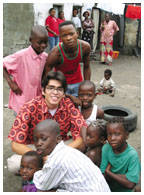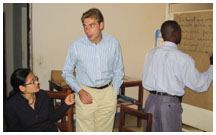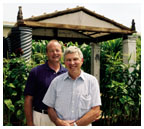September 15, 2004: Notebook
WWS students develop plan for war-torn Congo republic
FYI: Findings: Rockonomics 101
Education program yields first fruits
New members named to Board of Trustees
Robertson files amended lawsuit
Donors seek more input with gifts
WWS
students develop plan for war-torn Congo republic
Special tribunals might bring justice and stability to region
In the streets of Kinshasa, Adrian Alvarez *04 met children whose lives have been affected by the civil war in the Democratic Republic of the Congo. (Courtesy Adrian Alvarez *04) Lecturer William Burke-White, center, has served as an adviser for international criminal tribunals in East Timor, Rwanda, the former Yugoslavia, and the DRC. (Courtesy Dawn Hewett GS) |
Last October, 10 graduate students from the Woodrow Wilson School and their instructor, William Burke-White, traveled to Kinshasa, the capital of the Democratic Republic of the Congo, to develop a plan to prosecute those responsible for massacres and other atrocities during the recent Congolese civil war. Among the first people they interviewed was Thomas Lubanga, a rebel leader who allegedly directed a campaign of cannibalism in eastern Congo and could be put on trial if the DRC establishes a war-crimes tribunal. He appeared prepared for that possibility, arriving at the hotel coffee shop in a tailored suit, briefcase in hand, with a legal adviser at his side. He began asking his own questions, particularly about the crimes he is accused of committing.
“To us, that was shocking,” says Burke-White, a lecturer in public and international affairs who co-taught the international law workshop with Dean Anne-Marie Slaughter ’80. “If a rebel leader in eastern Congo has hired a lawyer to see whether he was violating the rules, it might mean people are thinking twice.”
The workshop, composed of second-year master’s students, was commissioned by U.S. Ambassador for War Crimes Pierre Prosper to study justice solutions for the DRC, which has seen 3 million war-related deaths in the past decade. In their 10-day trip to Congo, Uganda, and Rwanda, students interviewed more than 150 government ministers and other local leaders. Last spring, the group presented their report to the Department of State, the U.N. High Commissioner for Human Rights, and representatives of several E.U. nations. Next month, experts will discuss the document and several other reports from nongovernmental organizations at a conference in Amsterdam. A follow-up meeting, which will include representatives from the Congolese government, is planned for April in Kinshasa. The Princeton report relies partly on the idea of deterrence, calling for a special tribunal to try a limited number of war criminals. While the tribunal probably would leave thousands of criminals unpunished, it would provide some justice, discourage future atrocities, and allow the nation’s fragile government to move forward.
The Congolese conflict has been called a civil war, but foreign influences played a significant role. Eight countries and dozens of militias fought in the war, with a peak involvement of 60,000 foreign troops. Atrocities included massacres of civilians, torture, and sexual crimes. Prosecuting war criminals could spark unrest from domestic and foreign militias, upsetting the delicate balance of the current transitional government, notes Burke-White. “While the crimes committed were horrendous and need to be punished, even worse for people today in Congo would be if the country rolled back into a civil war,” he says.
Traveling to the DRC gave the students a clearer view of the country’s precarious state. Dawn Hewett GS, who had worked as an intern at the Truth and Reconciliation Commission in Sierra Leone, saw that while the DRC’s war was ostensibly over, “there was no victory – the warring factions are actually represented in the transitional government.” When Mariyan Zumbulev *04 spoke with leaders in Kisangani, a city in the central part of the country that had seen heavy fighting during the war, he found that citizens want justice, but they also value peace. Balancing the two poses challenges.
The students proposed a special court with limited jurisdiction to prosecute the people most responsible for the atrocities during the civil war — “a few dozen,” according to the report. The court would be supported by a regional justice commission, which would promote cooperation in handing over suspects who attempt to hide in neighboring countries. According to Jordan Tama *04, who interviewed government officials in Rwanda and Uganda, the plans would be a major advance for Congolese justice. “Together, the special tribunal and the regional justice commission could do something to promote accountability and deter future war crimes,” Tama says. “Until people are held accountable for their crimes, there’s not much disincentive to those who commit them.”
By stimulating discussion among international leaders, the Princeton
proposal has already achieved a measure of success, but the ultimate goal
will not be realized, Burke-White says, until a tribunal begins convicting
those responsible for the crimes in the DRC. The project “grew from
a class to an issue that people really care about and are passionate about,”
Burke-White says. “After you’ve sat down with victims of this
conflict, it’s very hard to walk away.” ![]()
By B.T.

Ticket prices for rock concerts increased by 82 percent from 1996 to 2003, nearly five times as much as the Consumer Price Index, and according to economics professor Alan Krueger, prices have more room to grow. Krueger, who studied ticket prices from more than 200,000 rock concerts dating back to 1981, says that the concert industry has become more monopolized since the dawn of CD copying and music file sharing. In the past, artists had an incentive to price tickets lower and accept less profit, since greater concert attendance generally meant better album sales. But with more fans downloading music for free, individual artists have compensated by raising ticket prices. “I think there is still some unexploited monopoly power among the most popular artists,” Krueger says. “Paul McCartney sells out in a matter of minutes, for example, and Springsteen and Rolling Stones tickets sell for much more than their list price on eBay.”
Curbing carbon
Controlling carbon dioxide emissions and stopping the escalation of global
warming does not require major new technologies, conclude professors Stephen
Pacala and Robert Socolow, co-directors of Princeton’s Carbon Miti-gation
Initiative. In an article in the Aug. 13 issue of Science, they identify
15 existing technologies that could be expanded to prevent an increase
in greenhouse-gas emissions. Their study includes wind, solar, and nuclear
energy, as well as technologies that increase energy efficiency or capture
carbon emissions at their source. “If we decide to act, we will
need to reduce carbon emissions across the whole global economy,”
Socolow says. “We have the tools to do this, especially if we think
in terms of 50-year campaigns, not instant solutions.” ![]()

Chart by Steven Veach
The 2003–04 Annual Giving campaign, which raised $36,488,569,
was the second-most successful in history, behind only 2000–01’s
total of $36,698,032. The Class of 1979 contributed more than $6.2 million
and set a new 25th-reunion record. The Class of 1984 also set a new record
for a 20th reunion, raising more than $1.9 million. Almost 60 percent
of undergraduate alumni participated.
![]()

Education program yields first fruits
This fall, a University-sponsored program designed to help economically disadvantaged high school students prepare for selective colleges saw its first 20 graduates enter the world of higher education.
Sociology professor Miguel Centeno came up with the idea for the Princeton University Preparatory Program, a three-year course of study, in 2000, after serving on a University study group that examined college admissions. Realizing that kids in working-class families face more than financial-aid hurdles, Centeno urged administrators to create a program at Princeton that would help young people overcome class disadvantages. Co-founder John Webb, the director of Princeton’s Teacher Preparation Program, helped design the program’s curriculum.
Students attend summer classes and are enrolled in a year-round writing program. The summer classes cover literature, mathematics, writing, music, art, and other college necessities, such SAT preparation and tips for filling out applications. Sophomores and juniors make weekly excursions to cultural and historical landmarks, while rising seniors visit colleges and learn about the admissions process.
Centeno says there are not enough data to draw conclusions about PUPP’s
effectiveness, but anecdotal evidence suggests some success. One example:
Two of the program’s first graduates are members of Princeton’s
Class of 2008. ![]()
By B.T.

New members named to Board of Trustees
Top row: Kim Goodwin
’81, Rishi Jaitly ’04, Heidi Miller ’74. |
Six alumni have been named to Princeton’s Board of Trustees: Alumni elected three of the new trustees: Kim Goodwin ’81, managing director and chief investment officer for equities at State Street Research & Management; young alumni trustee Rishi Jaitly ’04, who was vice president of his class and now works at a nonprofit dedicated to improving college enrollment rates among low-income students; and Terdema Ussery II ’81, president and chief executive officer of the Dallas Mavericks professional basketball team and chief executive officer of HD-Net. The three will serve four-year terms.
Elected by the board to 10-year terms were former trustee Heidi Miller
’74, chief financial officer for Bank One; and Louise Sams ’79,
president of Turner Broadcasting’s international operations and
the company’s general counsel. Eric Schmidt ’76, chief executive
officer and chairman of Google Inc., will serve for four years.
![]()

The Robertson suit claims that foundation money was improperly used in construction of Wallace Hall. (Jay Barnes) |
Robertson files amended lawsuit
In June, William Robertson ’72 and four family members filed an updated complaint in their lawsuit against Princeton, alleging that the University diverted more than $100 million of foundation funds for “its own use and benefit” and overcharged the Robertson Foundation for Woodrow Wilson School expenses. The University responded with a statement saying that the claims will be disproved in court.
Charles ’26 and Marie Robertson, who are both deceased, established the Robertson Foundation in 1961, providing a gift of $35 million in stock to support a graduate program at the Woodrow Wilson School, where students dedicated to public service could prepare for careers in government service. Family members say foundation funds are used to support programs and construction projects that do not serve the foundation’s mission.
The Robertsons’ June filing cites an allegation, included in an
internal memo, of misuse of funds in the Office of Religious Life to back
the claim that Princeton has “a pattern and practice of diverting
donations from their intended purpose.” The University says that
the allegation in the memo was “thoroughly investigated and determined
to involve no wrongdoing.” A Sept. 24 hearing will determine if
the court accepts the amended complaint. The case is expected to be heard
in court in October 2005. ![]()
By B.T.

Donors seek more input with gifts
The continuing dispute between William Robertson ’72 and Princeton about the University’s use of Robert-son Foundation funds is only one example of a changing relationship between universities and donors, who are more likely to want greater control of how their gifts are used. “Donors are increasingly taking an active role in the administration of their gifts,” says David Bass, a director at the Council for Advancement and Support for Education.
The most prominent example involves a $300-million gift to the University of Arkansas, made by the heirs of Wal-Mart founder Sam Walton in 2002. The Walton family negotiated a categorical breakdown of how the money would be distributed, and the university agreed to compile an annual progress report to show the effects of the donation. In other cases, attempts at active management have caused conflicts. Yale returned a $20-million gift to an alumnus in 1995 after a dispute over the Western civilization program it was meant to fund.
Princeton’s vice president and secretary, Robert Durkee ’69, acknowledges the trend, but says that it has not been prevalent at Princeton. “We are going to see, nationally, more donors who have their own missions,” Durkee says. “They’re looking to make contributions with their dollars to advance whatever it is they’ve decided is their mission. All of our experience is with the opposite approach, where the interest is in supporting the University’s mission.”
About 95 percent of gifts to Princeton are unrestricted, but restricted gifts make up a significant portion of the overall funds donated: 57.2 percent in 2003—04. Vice President for Development Brian McDonald ’83 says his department aims to align donors’ goals with the University’s priorities. According to Senior University Counsel Lorraine Sciarra, legal agreements typically word restrictions as “preferences,” and if those preferences cannot be met, the University can use funds for the most closely related purpose available.
Robertson’s allegations concerning Princeton’s use of Robertson
Foundation funds have not had a noticeable effect on fund raising. Since
the suit was filed in July 2002, alumni participation in the University’s
Annual Giving campaign has remained strong (59.2 percent in 2003—04),
and top priorities such as the four-year residential college plan have
received significant restricted funds. “One of the things that is
really extraordinary about Princeton is how responsive the donors are
to funding the highest needs of the University,” McDonald says.
![]()
By B.T.

© 1990 Photo: Trustees of Princeton University |
Nineteenth-Century Photographs. On exhibit at the Art Museum through Oct. 24, these photographs represent the major trends in 19th-century photography, from daguerreotype to photogravure, and show the many ways in which the medium was used, from commercial portraiture to contemplative landscapes. The photograph of the Louvre, above, by the French pioneering photographer Edouard Baldus, dates from 1856-57 and is an example of his technical expertise.
Critic and biographer Hermione Lee, professor of English at Oxford University, will deliver three lectures in McCosh 50 on successive evenings at 8 p.m.: “Shelley’s Heart and Pepys’ Lobsters,” Sept. 27; “Jane Austen Faints,” Sept. 28; and “Virginia Woolf’s Nose,” Sept. 29. Lee wrote a critically acclaimed biography of Virginia Woolf (1999), and is at work on a biography of Edith Wharton. Her lectures spring from various moments related to the lives of her subjects, such as the moment when the body of the poet Shelley was being cremated on the shore of the Mediterranean, and a friend, Edward Trelawny, rescued Shelley’s heart from the flames.
CBS News correspondent Mike Wallace, co-host of television’s longest-running news magazine, will speak on “World Leaders on 60 Minutes,” at 4:30 p.m. Sept. 28 in McCosh 50.
Through Oct. 15, the Seeley G. Mudd
Manuscript Library will display several important
American Civil Liberties Union documents from the Brown v. Board of Education
Supreme Court decision, including the ACLU brief challenging the “separate
but equal” status quo, and letters about the brief.![]()

Princeton’s newest graduates are entering the work force with higher salaries than those offered to graduates last year, but more than a quarter chose graduate education instead of full-time employment.
Sixty-three percent of the Class of 2004, including those still seeking employment, planned to enter the job market while 26 percent planned to pursue graduate and professional programs.
Working students who reported their starting salaries were earning an average of $48,973, up from $47,515 in 2003. Financial services remained the most popular field, drawing 41 percent of the students in the job market. Among graduate students, law school is the most common pursuit.
Ninety-seven percent of the class responded to the survey, conducted
by the Office of Career Services. ![]()
By B.T.

Photo by Frank Wojciechowski |
Shade trees across campus exhibit broken twigs and brown leaves after
the cicadas buzzed about town this summer for their once-every-17-years
visit. Cicadas lay their eggs in slits in tree branches, which then wither
and break off.![]()

Photo by Frank Wojciechowski |
The metalwork from FitzRandolph Gate, the 99-year-old entrance to the
front campus, is in Massachusetts being restored in time for its 100th
birthday next year. Up the road at the Andlinger Center for the Humanities,
workers are erecting a new entrance, similar to the FitzRandolph Gate,
but not as grand. The refurbished main gates are expected to be back in
place in November.![]()

Photo by Beverly Schaefer |
Smack-dab in the middle of Princeton Borough, cornstalks
surround 11 architectural follies constructed by Princeton architects
who were inspired by Princeton writers. The project, Writers Block, paired
local architects with local writers, and the architects designed small
pavilions where people can sit, reflect, or read during September and
October. History professor emeritus James McPherson, right, stands with
Kevin Wilkes ’83 in front of the folly Wilkes designed. Other authors
include creative writing professors Paul Muldoon, Chang-rae Lee, and Joyce
Carol Oates; bioethics professor Peter Singer; politics professor Paul
Sigmund; and religion professor Cornel West *80. Architects include Juliet
Richardson ’78 *81; visiting architecture lecturer Terence Smith
*79; architecture professor Ralph Lerner; and Ron Berlin *79. ![]()

A dorm in Whitman College will be named after former dean of admission Fred Hargadon, who served Princeton from 1988 to 2003. A group of three current and former University trustees made a $3-million gift to build Hargadon Hall. The names of the donors and the amount they gave have not been made public.
Secretary of Energy Spencer Abraham announced in July that Princeton’s Plasma Physics Laboratory will be the site for the International Thermonuclear Experimental Reactor, an international initiative to develop nuclear fusion as a source of electricity and hydrogen.
In its newest ranking of the country’s best colleges, U.S. News and World Report places Princeton first, tied with Harvard. The University also came in first for the least debt incurred by students after graduation and came in second for best value.
Former President Harold Shapiro *64 has been selected for the U.S. Olympic Committee’s 11-member board of directors.
A team of four students this summer won the $4,000 second prize for
their short digital film, After Prom, in a contest sponsored by Microsoft.
Benjamin Eachus ’05, Jessica
Inocencio ’05, Gregory Marx ’07, and Andrew McConnon ’05
contrast scenes from 1950s etiquette films with scenes of urban dancers
displaying their moves in a parking garage. The film can be seen at www.imaginecup.com.
![]()










